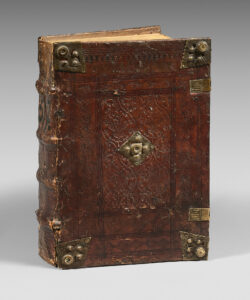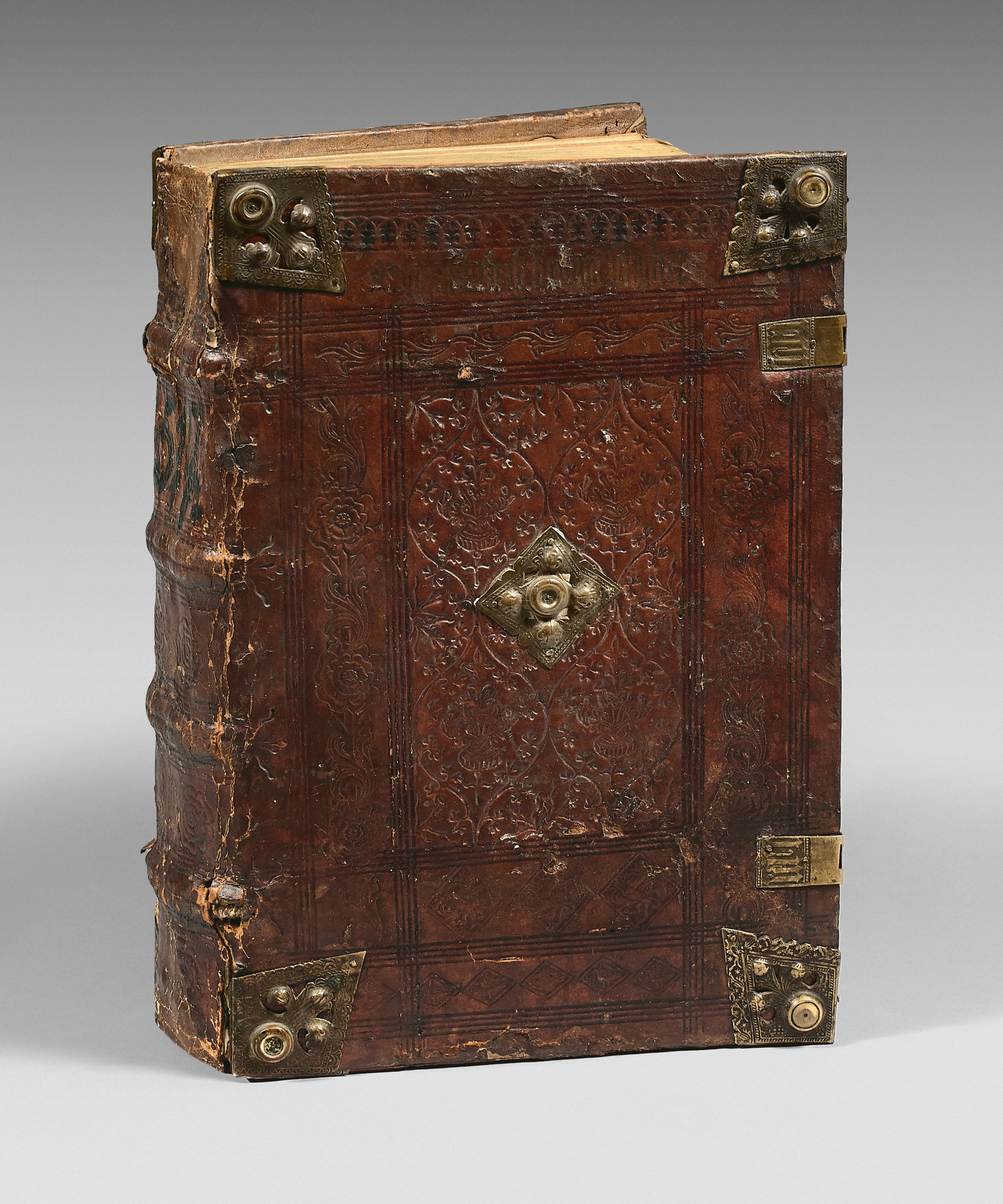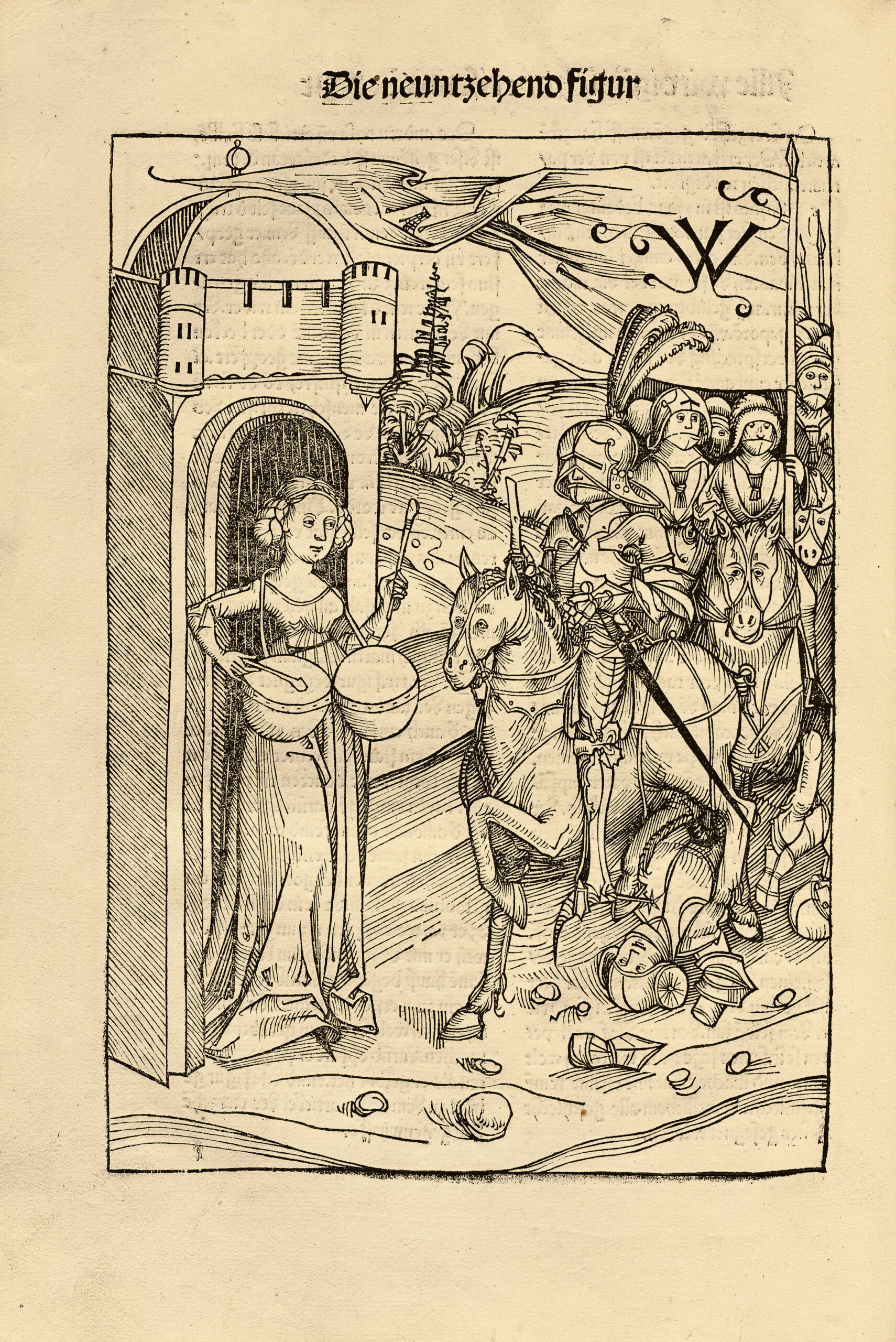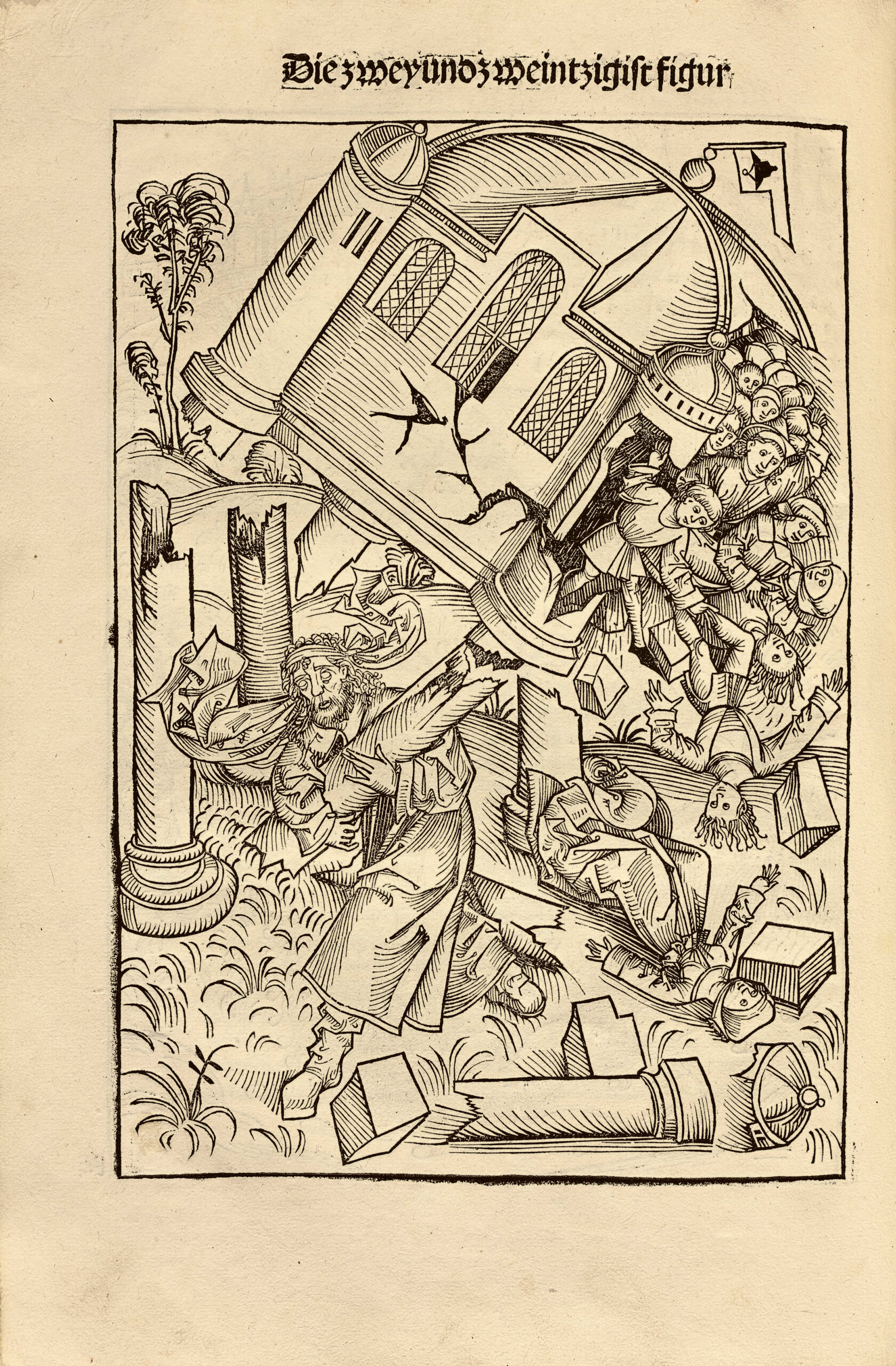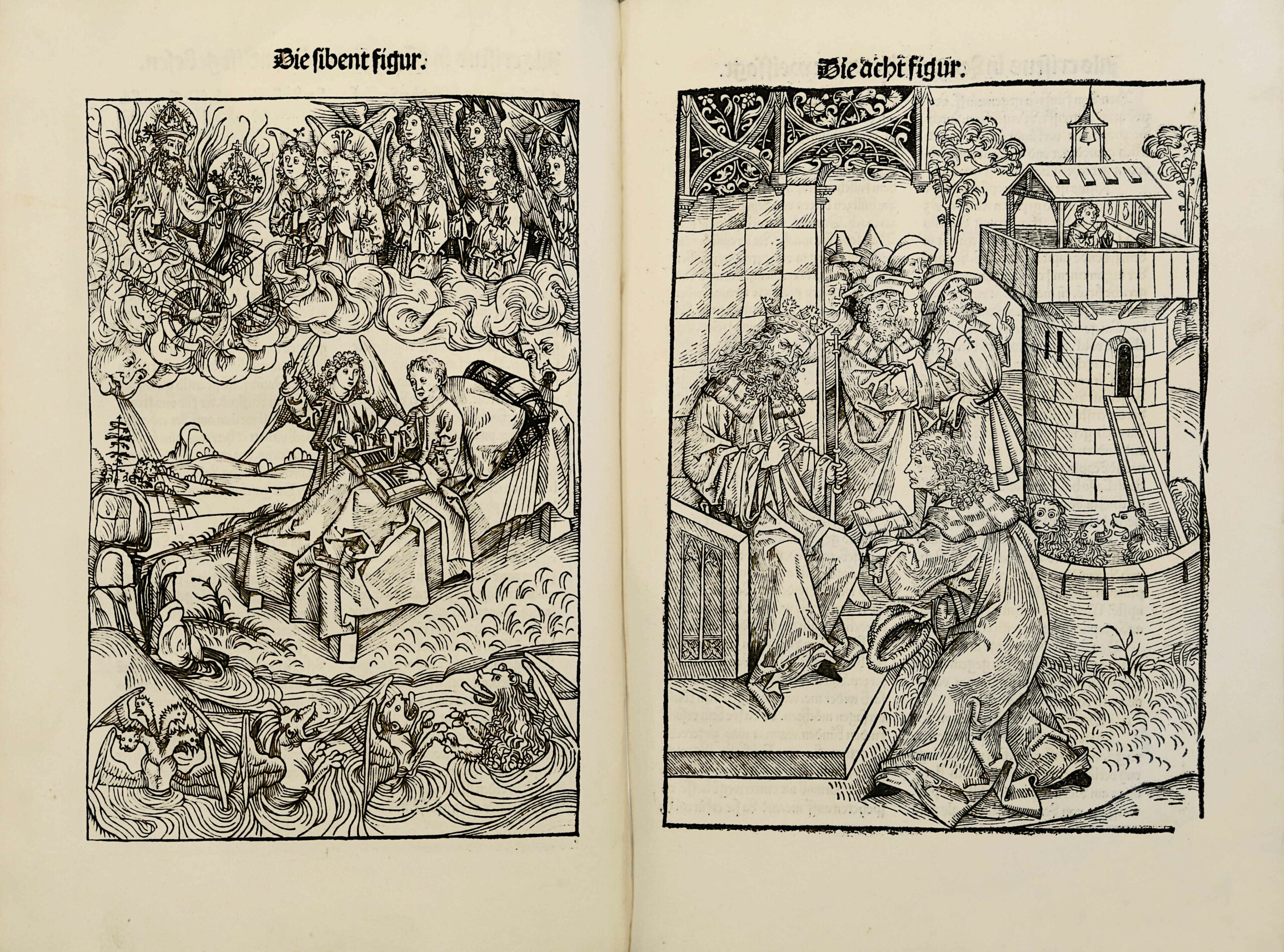Nuremberg, Anton Koberger, 8 November 1491.
Folio [329 x 228 mm] of (353) ll., signed a-z6 (a6 blc), ab-ad6, ae8, A-Z6, Aa-Gg6, Hh10 (Hh10 blc), small holes in the margin of the first 4 ll., large illuminated initial on the back of l. aiiii, former worm track in the inner margin of quires x,y and ab not touching the engraving, minor waterstain in the corner of ll. 310 to 311 and 340. The last leaf Hh10, blank, wasn’t preserved.
Brown calf over wooden boards, covers decorated with a blind-stamped decor of vegetal and animal patterns in fillets frames, five copper spandrels in the corners and the center, title of the work stamped in gilt letters on the upper cover [Schatzbehalt D’Ewige Seligkeit], spine ribbed and decorated with a repeated blind-stamped motif or roses, natural edges, remains of crafted clasps. Contemporary binding.
First and unique edition of this famous German mystic incunabula relating the life of Christ, printed in 150 copies only, according to the tradition.
The text was written by the Sisters of the Order of St. Clare in Nuremberg and edited by the Sisters of Charity in Pirckheim.
Hain 14 507; Copinger I. p.431; Panzer D. ann 313; Brunet v. 193; Proctor 2070; Polland II. p.434; Muther 423; Dogson I. pp.240-245; Passavant I. 67; Fairfax-Murray II. 392; BMC II. 434; Stillwell S. 280.
One of the most beautiful and most famous illustrated incunabula.
This work with Schedel’s Chronicle (1493) is one of the “two first important books with original illustrations published at Nuremberg”. Dogson I. pp. 241.2.
Der Schatzbehalter oder Schrein der wahren Reichtümer des Heils und der ewigen Seligkeit genant [Le Gardien du trésor, dit Écrin des vraies richesses du Salut et du Paradis éternel] was published in 1491, in Nuremberg.
The Schatzbehalter preceded by two years the Nuremberg Chronicle.
It is due to Franciscan monk Stephan Fridolin (c. 1430-1498), then preacher of the Sisters Poor Clares of the city, died in 1498. Steeped in theology, the work is based on the life of Christ. This is the main book of the author, who took advantage here of his immense erudition, acquired throughout his activities as a preacher and reader in the convents of Bamberg, Mainz and, from 1480, Nuremberg.
Printed by Anton Koberger, the work after the Breydenbach of 1486, is almost seen as the first illustrated book in Germany in the 15th century, of which the figures can be attributed with certainty to a famous artist, several plates bearing the signature of Wolgemuth.
The absolutely superb iconography is composed of 96 full-page (252 x 176 mm) large woodcuts, especially drawn for the text.
Due to Michael Wolgemuth (1434-1519), Durer’s Master, they attest of a great mastery of the artist in the composition of the various scenes, the richness of expression of the faces and the details precision especially for the clothes and the daily life.
Others are due to Wilhelm Pleydenwurff, to artists from the Wolgemuth’s artist studio and perhaps to Durer himself.
Michael Wohlgemuth occupied an incredible situation in Nuremberg and seems to have been considered there as the most eminent painter of his time.
“Durer who was his pupil admired him so much that he painted his portrait twice, the second time when he was 82 years old.” Benezit X 778.
This superb suite of different illustrations related to the life of Christ allows Wohlgemuth to interpret in powerful scenes the main episodes of the Bible and the New Testament: Terrestrial Paradise, Moses, Abraham, Nativity, Flight into Egypt, Baptism of Christ, Christ chasing the merchants of the Temple, the Last Supper, the Passion, the Last Judgment…
Many outdoor scenes are set in front of landscapes, fortified strongholds or contemporary buildings…
In addition to the main protagonists, many other characters move in clearly architectural settings or landscapes, whose role is both ornamental and symbolic.
Countless savory details concern the interior architecture, the arming, the ships, the means of transport and the customs of the time, the banquets and the costumes of the 15th century, especially the fashion for women.
Wide-margined copy, very pure and from a beautiful issue, preserved in its original binding.
Executed in Nuremberg, it is to be compared, by its ornamental vocabulary (bird, griffin, rosace, branch) with a Boethius belonging to the Foundation Schäfer and with the Schatzbehalter from J. R. Ritman’s library.
The text, adorned with a large illuminated initial, was rubricated in red and blue.
The paper has kept all its original qualities.
Small defects on the binding.
Provenance: ex-libris of the Baron Ferdinand Hoffmann (1540-1607), engraved by Lucas Kilian (1579-1637) after Mr. Göndolach. Ferdinand Hoffmann, lord of Grünbüchel and Strechau, had gathered a collection of books composed of more than ten thousand prints and manuscripts, he had acquired the entire Hieronymus Holzschuher’s library, famous doctor from Nuremberg and friend of Durer, who himself had inherited from his father-in-law’s library, Hieronymus Münzer, doctor, cartographer and collector of science books; Prinz Ferdinand von Dietrichstein (?) (1628-1698), to whom the heirs of Hoffmann gave the library of their ancestor and who, in 1669, moved it to the Castle of Nikolsburg in Moravia (two sales were organized in November 1933, and June 1934 but none of the catalogs mention the copy); Paul Harth (ex-libris) (sold for 44 673 € on March 1st 1987, 32 years ago, by Sotheby’s); Pierre Bergé; Marc Litzler.
Goff S-306; GW 10329; BMC II 434 (fo a copy in contemporary binding; dim. : 333 x 233 mm); Arnim, Katalog der Bibliothek Otto Schäffer, 1,302 (“It is said that the edition was only printed in 150 copies”); Muther, 423 (« The first book produced by the Koburg press with illustrations that were certainly prepared under the supervision of Wolgemuth is the 1491 ‘Schatzbehalter oder Schrein der wahren Reichtümer des Heils und ewiger Seeligkeit’ »); Needham, Twelve Centuries of Bookbindings, 400-1600, n° 30, note 9 and n° 92; Schäfer, Europaïsche Einbandkunst Aussechs Jahrhunderten, n° 15; Seaver, Maps, Myths, and Men. The Story of Vinland Map, Stanford UP, 2004, pp. 339-352 (« A Moravian Castle Library »).
